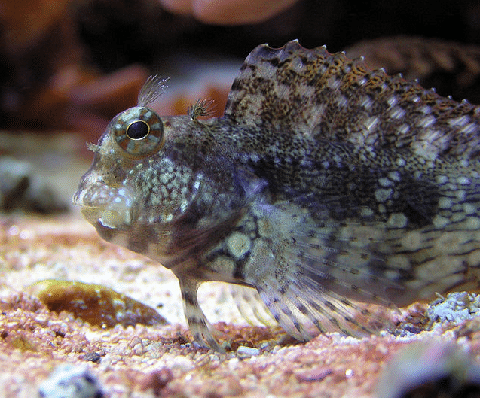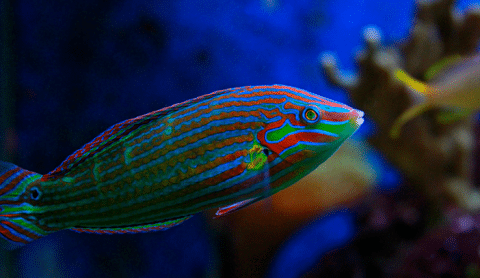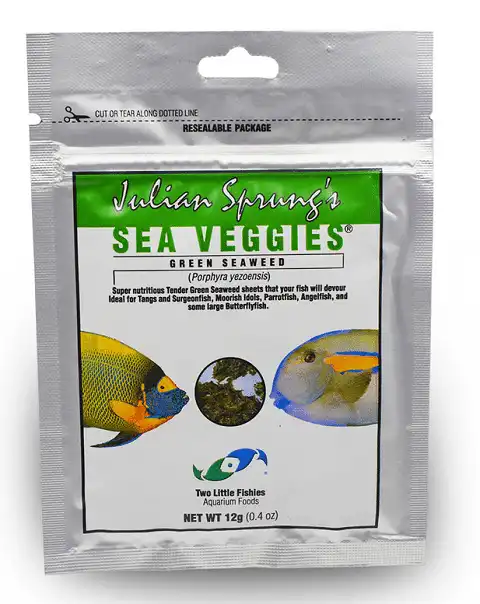Thank you for visiting! By the way… any links on this page that lead to products on Amazon and other stores/partners are affiliate links Aquarium Store Depot earns a commission if you make a purchase.
The Lawnmower Blenny, also referred to as the sailfin or algae blenny, is a must-have for saltwater aquariums. Not only does this saltwater aquarium fish provide practical benefits such as consuming nuisance algae, but they’re interesting and full of personality, making them an ideal choice for beginners and experienced aquarists alike. Let’s investigate what it takes to create an optimal environment for these blennies so that your tank can remain clean, algae free, and have plenty of character!
We’ll uncover information on their natural habitat along with identifying unique characteristics common in Lawnmower Blennies. We will look into suitable tank mates alongside reef tank considerations plus warning signs when it comes to health issues. By following our guide, you will be fully prepared before adding one to your own saltwater setup!
Key Takeaways
- Lawnmower Blennies are popular saltwater fish that provide algae-eating abilities and lively behavior.
- They need a 30 gallon tank minimum (55 gallon tank recommended) with live rock, sand substrate, & filter to thrive.
- While omnivorous in captivity, these blennies need a greens heavy diet to survive
- Avoid other blennies or aggressive predators for compatible tank mates.
Species Overview
| Scientific Name | Salarias fasciatus |
| Common Names | Lawnmower Blenny, Algae Blenny, Jewelled Rockskipper, Rock Blenny Family: Blenniidae, Rock Skipper Blenny |
| Family | Blenniidae |
| Origin | Indo-Pacific |
| Diet | Herbivore (Omnivore in captivity) |
| Colors | Mottled brown, tan, and white. |
| Care Level | Easy |
| Temperaturement | Peaceful (Semi-aggressive to other bottom dwellers) |
| Minimum Tank Size | 30 gallons (114 liters) 55 Gallons recommended (208 liters) |
| Max Size | 5 inches |
| Temperature Range | 76 – 82 degrees F (24 – 27 C) |
| pH Range | 8.0 – 8.4 |
| Salinity | 1.025 or 35 PPT |
| Reef Safe | Yes (May pick at inverts) |
Introduction
The Salarias fasciatus, also known as the Algae Blenny or Lawnmower Blenny Fish, is a species of saltwater fish commonly found in the Indian Ocean and Red Sea, as well as on the Great Barrier Reef. These unique creatures are an excellent addition to any aquarium due to their ability to consume excess algae, which makes them one of the few cleaner fish you can purchase in the hobby. The blennies provide liveliness similar to its close relatives such as Ecsenius gravieri (Sailfin).
Beginner aquarists can look after this species with ease because they’re quite hardy. Experienced fish owners will appreciate their attractive features coupled with their lively character.
Origin And Natural Habitat
Lawnmowers are native to many areas in the Indian Ocean, Fiji, Red Sea, Great Barrier Reef and other places such as Samoa and Micronesia. These fish normally live on shallow coastal grounds where they swim among rocks and coral rubble, usually alone around a depth of 50 feet.
To make sure these creatures stay happy when living in home aquariums, it is important to mirror their natural environment – warm water temperature, balanced alkalinity level, moderate lighting, which will let them have access to plenty of filamentous algae for consumption. In the wild, they roam the substrate and rocks for food, primarily eating detritus. Yes, that’s right. While they are called algae blenny commonly by trade, their main diet in the wild is detritus.
Physical Characteristics

Lawnmowers (also known as sailfin blenny) are unique in appearance, exhibiting rock and substrate like coloration with comb-like teeth (which is why they are also called combtooth blennies). The fish is also able to change color gradually going from light to dark to blend into the environment.
Also due to the shape of their specialized teeth, s fasciatus have no trouble scraping surfaces, the aquarium floor, or consuming hair algae making them an efficient eater. They often possess stripes, bands and spots ranging from hues of brown green or cream colors among others.
Males and females are easy to differentiate with this species. Females will have two spines on their anal fins which will be of differentiating lengths1.
Behavior And Personality
Lawnmowers possess a combination of curious and active behaviors. Usually peaceful fish, they can demonstrate aggression towards other algae eaters that encroach their turf. This hostility intensifies with age. They are even known to attack near relatives from different species!
Besides consuming algae matter, these fish may also enjoy small invertebrates, shellfish eggs or microscopic sponges to an occasional snack on minor snails.
It is advised to not mix this blenny with other blenny species because they are known for fighting. It is possible to add more than one in a longer tank, but that is usually reversed for tanks 6 feet or longer.
Life Expectancy
To provide your lawnmower Blenny with a long and healthy life, it is important to give them the ideal tank conditions, which should be kept clean at all times. Providing a balanced diet that meets their nutritional needs as well as ensuring good water parameters are essential for an extended lifespan. In general, these fish live between 2 to 5 years, depending on how they’re taken care of in captivity. It is not uncommon for them to live longer than this in captivity. They typically live longest in public aquariums or large reef tanks that are established. The longest I’ve personally seen reported was 9 years.
Average Size
Lawnmower blennies are an ideal option for saltwater aquarium owners, being a small fish that reaches 4-6 inches in size. They make an excellent tankmate due to their algae eating abilities, and they’re fairly easy to care for. These creatures can happily exist within many different types of tanks.
Caring For Your Lawnmower Blennies
For successful lawnmower blenny care, set up a fully-established saltwater aquarium with the correct parameters for them to thrive. This species is considered reef safe, though they may disturb corals with their perching behavior. They will pick at inverts like snails and starfish and have been known to eat small anemone shrimps. To prevent any harm occurring in your reef tank, make sure that this fish has access to plenty of algae as well as supplemental food sources. With proper maintenance, you’ll be able to appreciate their vivid colors and active behavior, which adds life and vibrancy to your marine environment.
Tank Size And Setup
A recommended tank size of 55 gallons is necessary to ensure that your lawnmower Blenny (also known as algae blennies) has a healthy environment, plenty of surfaces to graze off of, and optimal water quality. The larger home aquarium provides enough room for natural algae growth, allowing the development of an essential film that helps maintain health levels in fish. Waste can be diluted due to its spaciousness, and stabilized conditions are maintained through utilizing proper filtration.
When setting up their living space, provide them with live rock structures along with sand substrate. You can add just about any coral you like with these fish. All this creates ideal hiding places as well as enabling certain kinds of algae – to mimic what they would have in nature while making them feel more at home.
Available in either as live or dry sand. This sand is great for any reef tank setup.
Water Parameters
For your lawnmower to stay in optimal health, it is necessary for you to maintain the right water parameters. These fish need a pH balance between 8.0 and 8.4. Temperatures of 76°F-82°F. And salinity levels ranging from 1.020, 1.025 or 35 PPT in a reef tank must also be maintained. Keeping an eye on these conditions will ensure that this species has the best chance possible at living its longest life with vitality!
Maintaining cleanliness within their tank habitat should also be kept up. You should regularly test your water to ensure you have the water chemistry. You will also want to monitor key nutrient levels. Here are some other parameters to watch out for:
Feeding And Diet
Lawnmowers are quite efficient in grazing and cleaning your tank’s microalgae. To ensure proper nutrition, they should be provided with various prepared foods like flake food, dried seaweed, algae wafers, as well as brine shrimp or mysis. They will happily eat just about anything in captivity once established, but you will want to keep them with a plant based diet for their health. Here are some foods that work great for them:
- LRS Foods Herbivore Frenzy
- Mysis shrimp
- Masstick
- Sea Veggies by Two Little Fishies
- Reef Nutrition Chroma Boost
- Cultivated live foods like California Blackworms
- Cobalt Aquatics Marine Vegi Flake and Marine Omni Flake
Sea veggies is an amazing product for Tangs, Rabbitfish, and Marine Angelfish. Fish go crazy for it. Clean and easy to feed!
Frequency
Due to the fish’s feeding nature (they take over 3,000 bites a day!), It’s best to keep them well fed. Feeding lawnmower blennies requires feeding at least twice a day to keep them nourished. Grazing foods like Sea Veggies and Masstick are great to use with them so they can freely eat them. Strong filtration will offset the nutrients introduced by the extra food. This is why filtration is so important in reef tanks and why hobbyists go for sumps – as many fish require being constantly fed.
Tank Mates And Compatibility
Choosing the right tank mates for a Lawnmower Blenny is essential to ensure harmony in saltwater tanks. While these fish tend to be fairly peaceful, they might get aggressive when provoked or become territorial due to their age.
Maintaining several hiding spots within your community aquarium will also help reduce any risk of conflict between lawnmower blennies alongside other fishes, allowing everyone room enough while still enjoying being part of a communal setup!
Good Tank Mates

Lawnmowers can be an excellent addition to a saltwater aquarium, as they are compatible with many community fish. These could include:
- Blue Reef Chromis
- Royal Gramma Basslet
- Tang Fish like Yellow Tangs
- Most wrasses
- Dwarf angelfish
- Anthias
One thing to note about these fish is they are one of the rare fish that get along just fine with damselfish. In nature, they coexist happily in damselfish territories. They actually have a mutually beneficial relationship. The damsels will chase out mid and surface dwelling fish, while the blenny will chase out bottom dwelling fish. They also do not have dietary overlaps. If you are worried about damselfish aggressiveness, blennies tend to fit the bill regarding fit that will be tolerated.
Tank Mates To Avoid

When considering compatible tankmates for Lawnmower Blennies, aggressive and predatory fish such as Lionfish, Groupers, and Triggerfish should be avoided due to the potential threat they pose. More docile bottom dwellers like Gobies or Dragonets may not fare well either because of their competitive behavior over food resources and territories within the same aquarium.
Other blennies should be avoided since they can fit. Also, avoid any fish that can fit them into their mouths.
Common Health Issues And Prevention
Lawnmower Blennies are resilient saltwater fish species, making them a great addition to aquariums. Like all creatures, they can still be vulnerable to health problems if the environment is not optimal and cleanliness isn’t properly maintained.
Here are several issues you may run into with this fish:
- Marine ich
- Marine velvet
- Internal parasites
Internal parasites are one of the most common issues with these fish due to their feeding nature. To best prep your fish, a quarantine process along with a deworm/internal parasite removal practice of general cure + focus is good to use to clear them of such parasites.
A great general medication for various fish diseases. Can be used in water or fed direct with a binder like SeaChem Focus.
When purchasing this fish, you will need to ask the store you are purchasing from to feed the fish. Do not purchase a lawnmower blenny that is not eating, as its chances of accepting supplemental food in your tank will be low.
Breeding Challenges
Capturing Lawnmower. Blennies in captivity can be difficult as they are incredibly territorial and selective when it comes to mate selection. As of now, the majority that is sold commercially have been taken from their wild environment since there isn’t yet a successful protocol for breeding blenny fish in captivity.
This all changed in June 2023. the Biota Group, one of our leaders in saltwater fish tank breeding, announced a breakthrough that they can now captive bred this amazing fish. It is long overdue, and I’m glad Biota continues to do groundbreaking work in making this hobby more sustainable. I expect tank bred varieties to start arriving in stores by 2024.
Reef Tank Considerations

Lawnmowers are believed to be reef safe, although they have been known to nibble on coral polyps if put in an unfavorable situation. To protect the inhabitants of your reef tank, it is essential that you guarantee there is sufficient algae and supplemental foods for them so as to reduce any potential stressors or hunger issues. By providing adequate sustenance and creating a peaceful environment where possible, you can help ensure that no damage will occur due to lawnmowers looking for food elsewhere than what’s available in their natural habitat within your tank.
Frequently Asked Questions
Do lawnmower blennies eat hair algae?
Lawnmower blennies are commonly added to aquariums for their ability to consume hair algae. These small fish effectively feed on the pesky algae, providing a natural solution for this common issue.
Are lawnmower blennies hard to keep?
Lawnmower blennies are simple to take care of. Their diet can consist mainly of green algae with some added prepared fish food. The biggest challenge with the lawnmower blenny is getting them to eat supplemental foods. This is why you need to make sure they eat prepared foods at the store before you purchase them.
Are lawnmower blennies aggressive?
No, lawnmower blennies are generally peaceful and only display occasional aggression with other fish that look similar to them or those who prefer to swim around the bottom of the tank like dragonettes.
What do lawnmower blennies eat?
This herbivorous fish, the Lawnmower Blenny, feeds on a variety of plants including algae and diatoms as well as detrital matter. However, in captivity, they will eat an omnivorous diet. They will eat just about anything once adjusted to your tank.
Are Lawnmower Blennies suitable for beginner saltwater aquarists?
For the novice saltwater aquarist, Lawnmower Blennies are a great option due to their robustness and simplicity of care. They remain one of the easiest fish for any beginner in this field.
Closing Thoughts
The Lawnmower Blenny is a great choice for any saltwater aquarium due to its algae-eating ability, unique features, and lively personality. To ensure they flourish in the tank, you should make sure that your setup has been fully established with suitable water conditions as well as an assorted diet. When selecting compatible tankmates, be mindful of optimal parameters required for keeping these fish content long term. With proper care and attention provided, this captivating species will become one of the most popular members within your underwater ecosystem!
- About the Author
- Latest Posts
I’m thrilled that you found Aquarium Store Depot! Here you’ll find information on fish, aquariums, and all things aquatics related. I’m a hobbyist (being doing this since I was 11) and here to help other hobbyists thrive with their aquariums! I adhere to a high quality Editorial Process and Review products with real life field usage and practical analysis.








